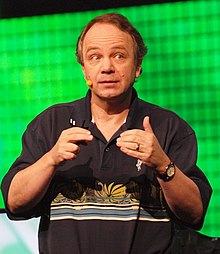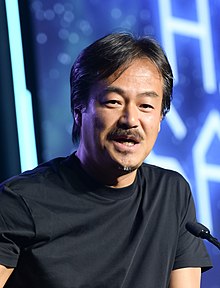Portal:Video games
The Video Games Portal

A video game or computer game is an electronic game that involves interaction with a user interface or input device (such as a joystick, controller, keyboard, or motion sensing device) to generate visual feedback from a display device, most commonly shown in a video format on a television set, computer monitor, flat-panel display or touchscreen on handheld devices, or a virtual reality headset. Most modern video games are audiovisual, with audio complement delivered through speakers or headphones, and sometimes also with other types of sensory feedback (e.g., haptic technology that provides tactile sensations). Some video games also allow microphone and webcam inputs for in-game chatting and livestreaming.
Video games are typically categorized according to their hardware platform, which traditionally includes arcade video games, console games, and computer (PC) games; the latter also encompasses LAN games, online games, and browser games. More recently, the video game industry has expanded onto mobile gaming through mobile devices (such as smartphones and tablet computers), virtual and augmented reality systems, and remote cloud gaming. Video games are also classified into a wide range of genres based on their style of gameplay and target audience. (Full article...)
Featured articles –
The game follows the five Simpsons family members—Homer, Marge, Bart, Lisa and Maggie—who learn they are part of a video game and are given superpowers to resolve several situations. Eventually, they must save their 8-bit predecessors from Will Wright, and the creator of their video game character selves, Matt Groening. The Simpsons family travels to four scenarios in parodies of other games to collect key cards used to infiltrate their creator's mansion and ultimately to save their predecessors from destruction to reverse their generations old ban on video games.
The game was met with mixed to positive reception from video game critics. They praised its visuals, writing, and faithfulness to the original material, while they criticized its short length and poor camera system, which did not always function properly. The Simpsons Game received the Best Game Based on a Movie or TV Show award at the 2007 Spike Video Game Awards and was nominated for Best Video Game Writing at the 2007 Writers Guild of America Awards. As of January 31, 2008, four million copies of the game have been sold worldwide. (Full article...)
Nintendo Entertainment Analysis & Development developed the game, led by director Takashi Tezuka and producer and series creator Shigeru Miyamoto. It is the first Mario game for the SNES and was designed to make the most of the console's technical features. The development team had more freedom compared to the series installments for the Nintendo Entertainment System (NES). Yoshi was conceptualised during the development of the NES games but was not used until Super Mario World due to hardware limitations.
Super Mario World is often considered one of the best games in the series and is cited as one of the greatest video games ever made. It sold more than twenty million copies worldwide, making it the best-selling SNES game. It also led to an animated television series of the same name and a 1995 sequel, Yoshi's Island. The game has been re-released on multiple occasions: It was part of the 1994 compilation Super Mario All-Stars + Super Mario World for the SNES and was re-released for the Game Boy Advance as Super Mario World: Super Mario Advance 2 in 2001, on the Virtual Console for the Wii, Wii U, and New Nintendo 3DS consoles, and as part of the Super NES Classic Edition. In 2019, it was released for Nintendo Switch Online as part of the classic games service. (Full article...)
Gameplay is presented from the third-person perspective with a primary focus on Spider-Man's traversal and combat abilities. Spider-Man can freely move around New York City, interacting with characters, undertaking missions, and unlocking new gadgets and suits by progressing through the main story or completing tasks. Outside the story, the player is able to complete side missions to unlock additional content and collectible items. Combat focuses on chaining attacks together and using the environment and webs to incapacitate numerous foes while avoiding damage.
Development of Marvel's Spider-Man, the first licensed game by Insomniac in its then-22-year history, began in 2014 and took approximately four years. Insomniac was given the choice of using any character from Marvel's catalog to work on; Spider-Man was chosen both for his appeal to the employees and the similarities in traversal gameplay to their previous game Sunset Overdrive (2014). The game design took inspiration from the history of Spider-Man across all media but Marvel Comics. Insomniac wanted to tell an original story that was not linked to an existing property, creating a unique universe (known as Earth-1048) that has since appeared in novels, merchandise, and comics. (Full article...)
F-Zero GX is the successor to F-Zero X and continues the series' difficult, high-speed racing style, retaining the basic gameplay and control system from the Nintendo 64 game. A heavy emphasis is placed on track memorization and reflexes. GX introduces a "story mode" element, where the player assumes the role of F-Zero pilot Captain Falcon through nine chapters while completing various missions.
The GX and AX project was the first significant video game collaboration between Nintendo and Sega. GX was well received by critics for its visuals, intense action, high sense of speed, and track design while its high difficulty has been criticized. In the years since its release it has been considered one of the GameCube's best titles, as well as one of the greatest video games ever made. (Full article...)
Development began shortly after the release of Christmas Nights in November 1996. Producer Yuji Naka wanted to create a game which involved saving people rather than killing them. Sonic Team used firefighting as they thought it was an effective way of having players identify with heroism.
Burning Rangers received mostly positive reviews. Critics praised the soundtrack and audio, particularly the voice navigation system. Some critics felt the graphics were among the best on the Saturn, but the collision detection and glitches were criticised. Burning Rangers was among the final seven Saturn games released in America. (Full article...)
Cyan began developing Uru shortly after completing Riven in 1997, leaving future Myst sequels to be produced by third-party developers. Uru required five years and $12 million to complete. Uru was initially conceived as a multiplayer game; the single-player portion was released, but the multiplayer component, Uru Live, was delayed, released, and then eventually canceled. The online video game service GameTap re-released the multiplayer portion of Uru as Myst Online: Uru Live in February 2007, but the service was canceled again the following year due to a lack of subscribers. GameTap passed the rights to Uru Live back to Cyan, who re-launched the game for free in 2010.
Uru was not as well received as previous Myst titles. Critics admired the visuals and new features of the game but criticized the lack of multiplayer in the retail version and clunky controls. Compared to previous games in the series, which had sold millions of units, Uru's sales were considered disappointing. The game was a critical and commercial disappointment for Cyan, causing the company financial troubles; nevertheless, it has attracted a cult following. (Full article...)
Doom was the third major independent release by id Software, after Commander Keen (1990–1991) and Wolfenstein 3D (1992). In May 1992, id started developing a darker game focused on fighting demons with technology, using a new 3D game engine from the lead programmer, John Carmack. The designer Tom Hall initially wrote a science fiction plot, but he and most of the story were removed from the project, with the final game featuring an action-heavy design by John Romero and Sandy Petersen. Id published Doom as a set of three episodes under the shareware model, marketing the full game by releasing the first episode free. A retail version with an additional episode was published in 1995 by GT Interactive as The Ultimate Doom.
Doom was a critical and commercial success, earning a reputation as one of the best and most influential video games of all time. It sold an estimated 3.5 million copies by 1999, and up to 20 million people are estimated to have played it within two years of launch. It has been termed the "father" of first-person shooters and is regarded as one of the most important games in the genre. It has been cited by video game historians as shifting the direction and public perception of the medium as a whole, as well as sparking the rise of online games and communities. It led to an array of imitators and clones, as well as a robust modding scene and the birth of speedrunning as a community. Its high level of graphic violence led to controversy from a range of groups. Doom has been ported to a variety of platforms both officially and unofficially and has been followed by several games in the series, including Doom II (1994), Doom 64 (1997), Doom 3 (2004), Doom (2016), Doom Eternal (2020), and Doom: The Dark Ages (2025), as well as the films Doom (2005) and Doom: Annihilation (2019). (Full article...)
Doom was announced as Doom 4 in 2008, and that version underwent an extensive development cycle with different builds and designs before the game was restarted in 2011 and revealed as simply Doom in 2014. It was tested by customers who pre-ordered the 2014 MachineGames game Wolfenstein: The New Order and the general public. Mick Gordon composed the music, with contributions by Richard Devine. The game also has an online multiplayer component and a level editor known as "SnapMap", co-developed with Certain Affinity and Escalation Studios respectively.
Doom was well received by critics and players. The single-player campaign, graphics, soundtrack, and gameplay received considerable praise, whereas the multiplayer mode drew significant criticism. It was the second best-selling video game in North America and the UK in the week of its release and sold over 500,000 copies for PCs by the end of May 2016. A sequel, Doom Eternal, was released in March 2020. A prequel, Doom: The Dark Ages, is set to be released in 2025. (Full article...)
Did you know... -
- ... that a cheat code for the 2003 video game Hulk is hidden in a scene of the film it is based on?
- ... that Kainé from the video game series Nier was created in response to a female staff member's vague wish for a "male heroine"?
- ... that the video game Serious Sam: Tormental was originally inspired by Geometry Wars?
- ... that the video game Manor Lords was wishlisted more than three million times on Steam after its developer had estimated it would receive around 14,000?
- ... that Tetris Holding won an injunction in 2012 to stop sales of a video game clone of their famed Tetris game?
- ... that the 2015 video game Worlds of Magic, intended as a spiritual successor to the classic game Master of Magic, failed to impress most reviewers?
- ... that Through the Darkest of Times was the first video game published in Germany to use swastikas?
- ... that the case Lewis Galoob Toys, Inc. v. Nintendo of America, Inc. was considered essential to the future of video game modding in the United States in 1992?
- ... that development on the video game Expeditions: Rome was not affected by lockdowns from the COVID-19 pandemic because the developer was already split between Copenhagen and Istanbul?
- ... that when Kaz Ayabe pitched his video game Boku no Natsuyasumi to Sony, he said that illustrator Mineko Ueda was interested in the project even though they had never actually met?
- ... that deceased YouTuber Technoblade beat the video game Minecraft in hardcore mode using a racing-wheel controller?
- ... that before Sarah Elmaleh voiced the player character in the video game Anthem, developed by BioWare, she voiced characters in a mod of an earlier BioWare game?
Selected biography –
Selected image -

Recent video game-related events
- May 24, 2024 – Uvalde school shooting
- Families in Uvalde, Texas, U.S., file a lawsuit against Daniel Defense and Activision Blizzard for creating the DDM4 V7 gun and promoting the weapon through the game Call of Duty, respectively. They also sue Meta Platforms for owning Instagram, which was used by the gunman. (AP)
- April 16, 2024 – 2023–2024 video game industry layoffs
- American video game company Take-Two Interactive lays off 5% of its workforce. (Reuters)
- April 10, 2024 – 2023–2024 video game industry layoffs
- American video game company Epic Games announces that it will lay-off around 870 employees, roughly one-sixth of its workforce, due to slower growth than expected. (CBC via Yahoo! News)
Topics
Categories
Things you can do
In other Wikimedia projects
The following Wikimedia Foundation sister projects provide more on this subject:
-
Commons
Free media repository -
Wikibooks
Free textbooks and manuals -
Wikidata
Free knowledge base -
Wikinews
Free-content news -
Wikiquote
Collection of quotations -
Wikisource
Free-content library -
Wikiversity
Free learning tools -
Wiktionary
Dictionary and thesaurus













































